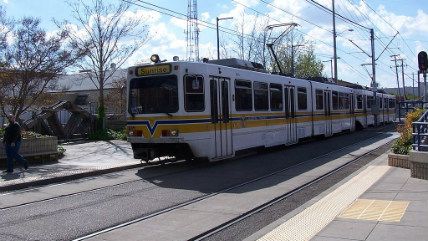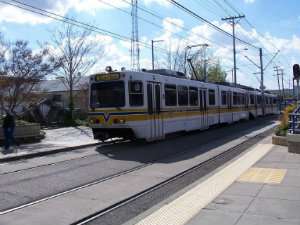Congress's Budget Bill Spends Billions on Useless Light Rail
Trump's abandoned "skinny budget" would have cut wasteful rail spending.


Few lovers of government largesse are more ecstatic with the 2017 Omnibus Appropriations bill than those crazy devotees of huge public transit projects.
Following passage of the bill, the American Public Transportation Association (APTA) issued a statement applauding Congress for "acting in line with the wishes of the American people" and refusing to eliminate even one of the billions of dollars earmarked for light rail and street car projects across the country.
Just a month ago, these advocates and their supporters in Congress had been fretting about Trump's "devastating" skinny budget and a proposed cut 13 percent cut to the Department of Transportation. The federal government currently pays for some 43 percent of all capital spending on public transit.
But thanks to a steady stream of open letters, questionable economic studies, and advocacy from bi-partisan boosters of public transit within Congress, these cuts were jettisoned from the final budget deal struck on Monday.
The new spending plan gives the Department of Transportation (DOT) an overall discretionary budget of $19.3 billion, a $681 million increase over 2016 funding levels. Hardly the 13 percent cut initially proposed.
Given new life under these increased funding levels is the Transportation Investment Generating Economic Recovery (TIGER) grant program, which Trump's budget blueprint had eliminated in its entirety.
Initially created as an economic recovery program under the Obama Administration's stimulus plan, these TIGER grants have gone on to dole out $4.6 billion to transit projects in the years since the Great Recession has ended, and not without controversy.
A 2014 Government Accountability Office report found the Department of Transportation had violated its own internal control practices in administering the TIGER program, giving grants to projects that applied after deadlines or which were rated inferior to other applicants.
The GAO report also found that DOT failed to document the reasons for these violations of its internal controls which it warned could "give rise to challenges to the integrity of the evaluation process and the rationale for the decisions made." You don't say.
Monday's spending bill gives TIGER another $500 million.
Also living to spend another day is the Capital Investment Grants (CIG) program which, like TIGER, funnels money to state and local agencies and transit authorities for various public transit projects.
Trump's "skinny budget" proposed ending these grants for all projects but those in the final agreement stage with the Department of Transportation. "New transit projects," according to the budget document, "would be funded by the localities that use and benefit from these localized projects."
This provision panicked local transit authorities who had sold voters on infrastructure plans assuming those federal grants would be forthcoming. Seattle's Lynnwood light rail extension, Tempe, Arizona's new Streetcar project, and others faced cancellation without significant tax increases and borrowing at the state and local levels.
Thanks to a $2.4 billion appropriation to the CIG program, however, 18 public transit projects were spared. Lynnwood in Seattle will get a taxpayer gift of $125 million, while Tempe Streetcar will receive $50 million, almost a third of its overall cost.
Also included in the new congressional budget plan is another $1.5 billion for America's perennial transit loser, Amtrak.
The death of Trump's proposed cuts to wasteful light rail spending should hardly be a surprise. As APTA points out in their Monday press release, three of four Americans favor of increasing spending on public transportation. Their elected representatives in Washington are only too happy to give it to them.
Poll popularity aside, Congress's budget plan accounts for barely 3 percent of passenger miles traveled in urban areas. Public transit is the most expensive form of transportation, costing $1.15 per passenger mile, nearly five times the cost of the same mile by car.
Trump's proposed cuts to programs like CIG and TIGER offered a brief, tantalizing hope the federal government would step away from costly transit options that are actually used by fewer and fewer people.
Monday's transit deal is a reminder representatives of both major political parties will always spend your tax money—however ineffectively—in the hopes of remaining in office.
Rent Free is a weekly newsletter from Christian Britschgi on urbanism and the fight for less regulation, more housing, more property rights, and more freedom in America's cities.

Show Comments (13)